During the spring and summer seasons in West Virginia, yellow birds are a common sight, especially with the arrival of warblers. However, in the winter, only the American Goldfinch can be easily spotted, representing the most commonly seen yellow bird in the region.
This comprehensive guide is designed to assist you in identifying the various yellow birds found in West Virginia. It provides you with pictures, details for identification, recordings of their songs, and information about their migration patterns.
The majority of yellow birds in West Virginia are warblers, orioles, or tanagers. Occasionally, you may come across female birds that look strikingly different from their male counterparts within the same species.
With the wealth of information contained in this guide, identifying yellow birds will become a much simpler task. The birds are listed in the order of their frequency of sightings in West Virginia during the spring and summer months of May and June, as recorded in ebird checklists.
Yellow birds present in West Virginia throughout the year include the American Goldfinch. In the summer, you may encounter the Cedar Waxwing, Scarlet Tanager, Common Yellowthroat, Black-throated Green Warbler, American Redstart, Eastern Meadowlark, Baltimore Oriole, Yellow Warbler, Hooded Warbler, Yellow-throated Warbler, White-eyed Vireo, Yellow-throated Vireo, Orchard Oriole, Magnolia Warbler, Pine Warbler, Blue-winged Warbler, Prairie Warbler, Canada Warbler, Summer Tanager, Prothonotary Warbler, Dickcissel, and Yellow-headed Blackbird.
During the winter months, the Yellow-rumped Warbler and Evening Grosbeak may make an appearance in West Virginia. As for their migration periods, keep an eye out for the Palm Warbler, Cape May Warbler, Nashville Warbler, Wilson’s Warbler, and Orange-crowned Warbler.
So, continue reading to discover the identity of those yellow birds you have recently spotted!
West Virginia’s 30 Yellow Birds:
1. American Goldfinch
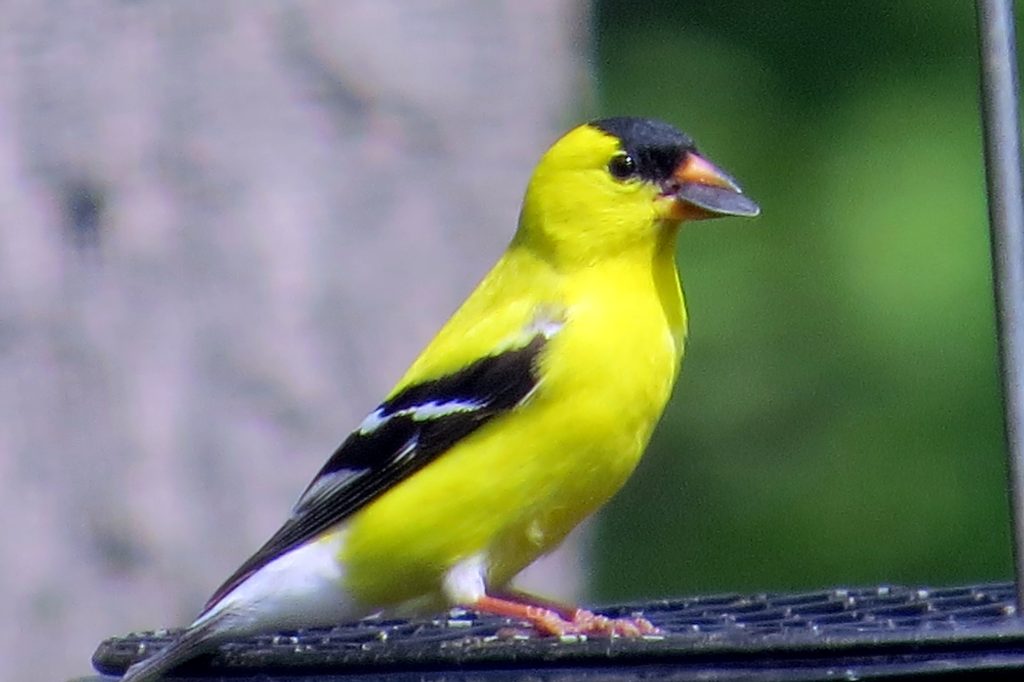
Throughout the year, American Goldfinches can be observed in West Virginia. However, their numbers tend to increase during the breeding season. Bird watchers in the state have recorded their presence in 43% of summer checklists and 29% of winter checklists.
American Goldfinches are highly popular birds. In spring, the males exhibit vibrant yellow and black plumage, while the females appear in a duller brown coloration. During the winter, both males and females display a more subdued appearance.
Spinus tristis
Length: 4.3-5.1 in (11-13 cm)
Weight: 0.4-0.7 oz (11-20 g)
Wingspan: 7.5-8.7 in (19-22 cm)
American Goldfinches can be found across most of North America and tend to be resident throughout the year. However, those that breed in Canada and the Midwest migrate to the southern states of the US for the winter season.
You can spot American Goldfinches foraging in weedy fields and overgrown areas, where they feed on sunflower, thistle, and aster plants. These delightful birds are also commonly observed in suburban areas, parks, and even backyards.
Song of the American Goldfinch:
American Goldfinches usually construct their nests in saplings or shrubs. The nests are composed of grass, bark strips, and feathers, providing a cozy spot for the female to lay four to six eggs. The eggs hatch within ten to twelve days, during
which time the male diligently feeds the female while she incubates the eggs.
To attract American Goldfinches to your backyard, consider planting thistles and milkweed. These birds are known to visit various bird feeders and particularly enjoy sunflower and nyjer seeds.
Fun Fact: Brown-headed Cowbirds have a reputation for laying eggs in American Goldfinch nests. However, the seed-based diet provided by the Goldfinch parents is unsuitable for the cowbird chicks, leading to their eventual demise.
2. Cedar Waxwing
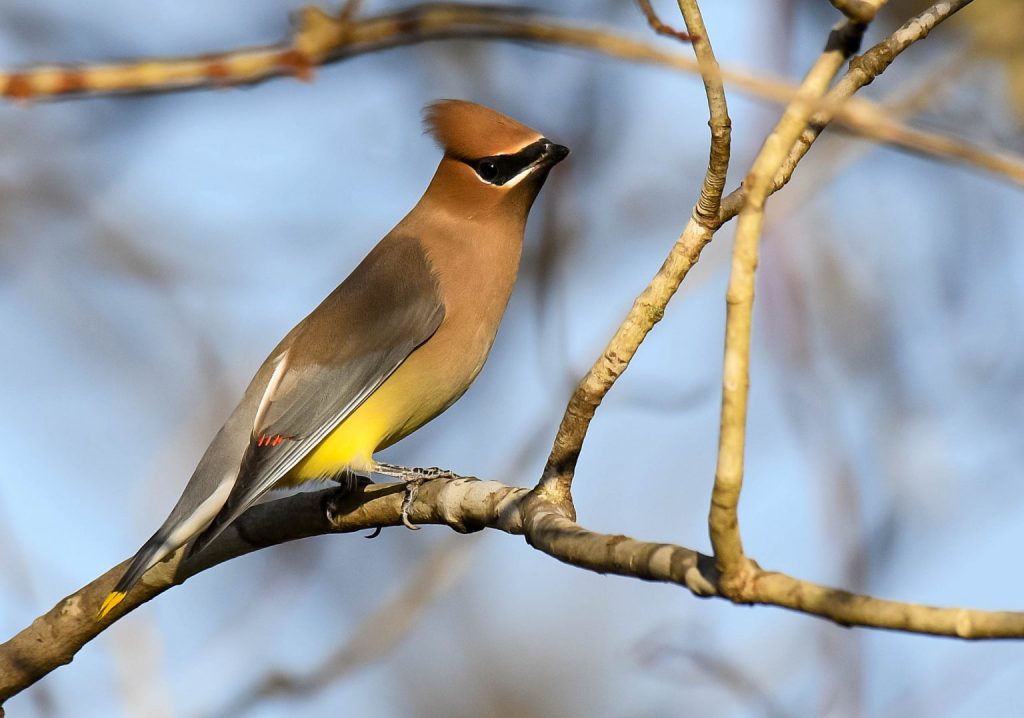
Cedar Waxwings can be spotted year-round in West Virginia, with a greater prevalence during the breeding season. They appear in 22% of summer checklists and 2% of winter checklists.
These elegant and sociable birds feature pale brown coloring on their heads, chests, and crests, which transitions to a gray hue on their backs and wings. Their bellies exhibit a delicate shade of pale yellow, with bright yellow accents on the tips of their wings. Cedar Waxwings possess a distinctive narrow black mask over their eyes, accompanied by vibrant red wingtips.
Bombycilla cedrorum
Length: 5.5-6.7 in (14-17 cm)
Weight: 1.1 oz (32 g)
Wingspan: 8.7-11.8 in (22-30 cm)
Cedar Waxwings breed in Canada before embarking on migration journeys to the southern states of the US, Mexico, and Central America for the winter season. They are known to be resident throughout the year in the northern regions of the US.
These birds can be found amidst berry bushes, woodlands, grasslands, urban areas, and along streams. While they primarily feed on fruit, they also consume insects during the summer months.
Cedar Waxwing’s Vocalization:
Credit: Peter Ward and Ken Hall, XC512254. Accessible at www.xeno-canto.org/512254.
Nests constructed by Cedar Waxwings are typically situated in trees, fashioned from twigs, grass, hair, and plant materials. The interior of the nest is lined with pine needles and soft grass. The female lays up to six eggs, which take approximately twelve days to hatch. Subsequently, the young birds require an additional sixteen days or so to leave the nest.
To attract Cedar Waxwings to your backyard, consider planting native trees and shrubs that bear small fruits. Examples include serviceberry, dogwood, juniper, winterberry, and hawthorn. Additionally, you may entice them with fruit offerings on platform feeders.
Fun Fact: Cedar Waxwings engage in a unique courtship behavior by exchanging gifts with their potential mates.
3. Female Scarlet Tanager
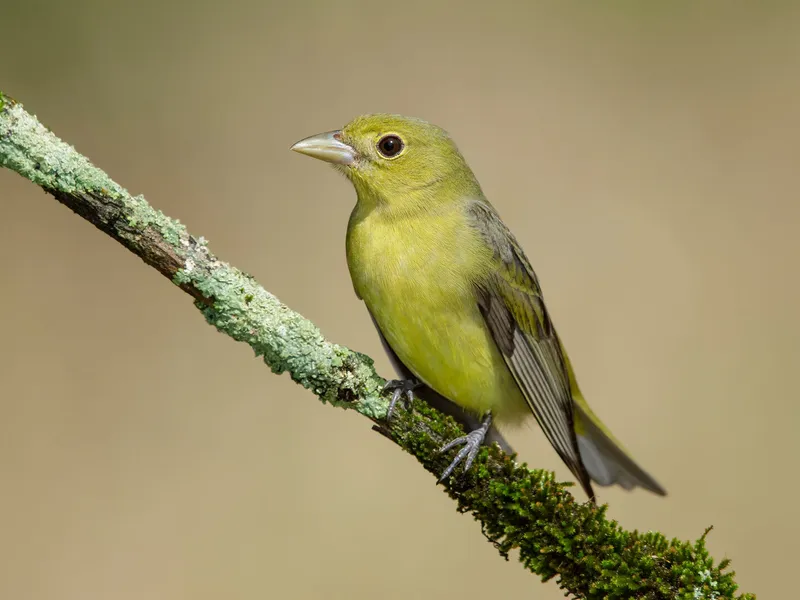
Scarlet Tanagers are prevalent in West Virginia during the summer months, primarily from April to October. Approximately 26% of checklists during this period report sightings of these birds.
Female Scarlet Tanagers exhibit a yellowish coloration with darker wings and tails. Similarly, after molting, the males display a similar appearance.
Male Scarlet Tanagers are resplendent with their vibrant red plumage, contrasting sharply against their black wings and tails. These striking birds boast thick bills and possess relatively short tails.
Piranga olivacea
Length: 6.3-6.7 in (16-17 cm)
Weight: 0.8-1.3 oz (23-38 g)
Wingspan: 9.8-11.4 in (25-29 cm)
During the summer season, Scarlet Tanagers breed in eastern forests before embarking on migrations to western South America. They can be observed in southeastern US states during their migratory journeys.
Scarlet Tanagers tend to remain high in the forest canopy, making them somewhat challenging to spot. However, you may catch a glimpse of their red brilliance as they traverse branches in search of insects.
Melodious Song of the Scarlet Tanager:
Credit: Christopher McPherson, XC599850. Accessible at www.xeno-canto.org/599850.
Scarlet Tanager nests are constructed by females within a span of approximately four days, utilizing loosely woven twigs, grass, and plant materials. The interior of the nest is lined with soft grass, pine needles, and other cozy materials. The female lays about four eggs, which incubate for two weeks, followed by another two weeks for the young birds to fledge.
To attract Scarlet Tanagers, consider planting berry-producing plants such as blackberries, raspberries, huckleberries, juneberries, serviceberries, mulberries, strawberries, and chokeberries.
Fun Fact: Male Scarlet Tanagers engage in singing battles, sometimes escalating into actual physical fights.
4. Common Yellowthroat
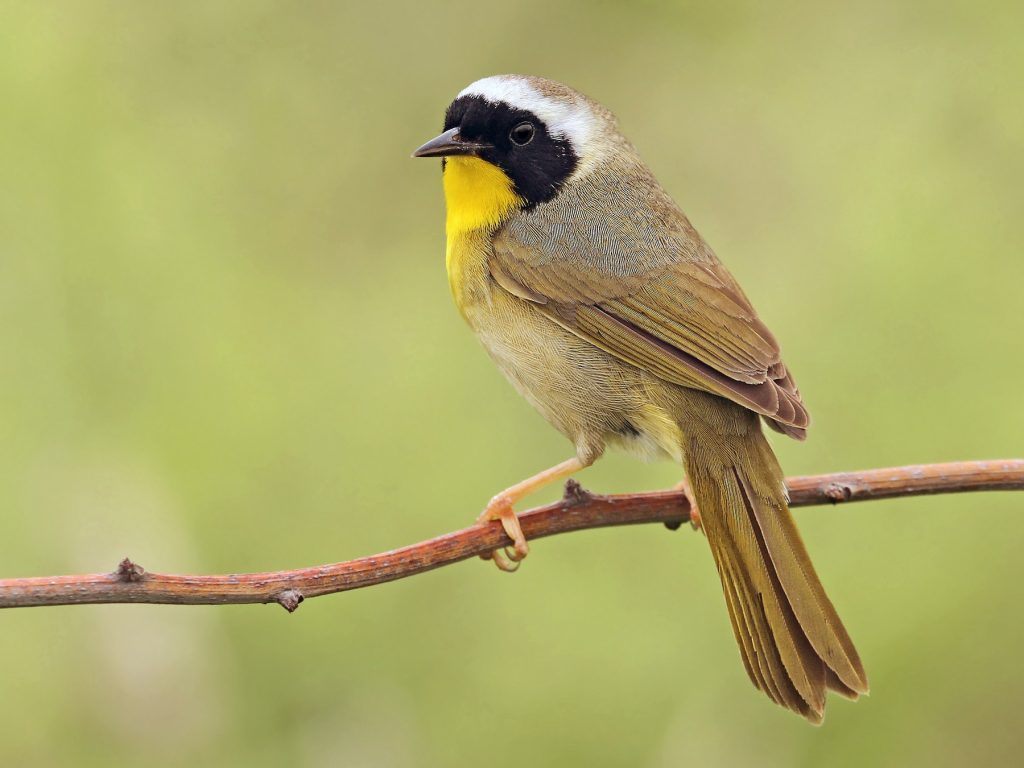
Common Yellowthroats are frequently observed in West Virginia during the breeding season, appearing in 22% of summer checklists.
These small songbirds exhibit brownish coloring on their backs and vibrant yellow plumage underneath, accompanied by long tails. Male Common Yellowthroats possess black masks across their faces. The intensity of the yellow coloration can vary geographically, with some individuals displaying a more olive tone on their undersides.
Geothlypis trichas
Length: 4.3-5.1 in (11-13 cm)
Weight: 0.3-0.3 oz (9-10 g)
Wingspan: 5.9-7.5 in (15-19 cm)
Common Yellowthroats spend their summers breeding across a vast expanse of North America, excluding Alaska and northern Canada. Certain populations remain resident along the Gulf Coast and in the Pacific Southwest. Subsequently, they migrate southward during the winter season.
You are likely to encounter Common Yellowthroats in marshy areas, wetlands, and brushy fields where thick vegetation thrives.
Captivating Melody of the Common Yellowthroat:
Credit: Paul Marvin, XC629250. Accessible at www.xeno-canto.org/629250.
Nests constructed by Common Yellowthroats are situated near the ground, primarily in marshy regions supported by reeds. Composed of grass and sedges, the nests rest upon a platform made of leaves and grass. Females lay up to six eggs, which hatch in around twelve days, followed by an additional period of two weeks for the young to leave the nest.
To attract Common Yellowthroats to your backyard, create a habitat with dense vegetation and native plants that attract insects.
Fun Fact: The black mask displayed by Common Yellowthroats serves as a visual signal to courting males, leading them to attack fake birds with masks. However, they do not respond aggressively to birds lacking the distinctive mask pattern.
5. Yellow-rumped Warbler
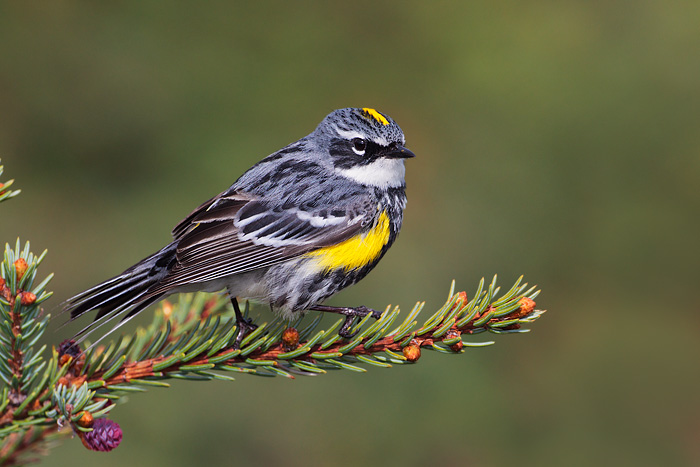
Yellow-rumped Warblers predominantly grace West Virginia during the winter months. However, some sightings occur in the eastern part of the state during the breeding season.
During the fall migration in October, their numbers increase, appearing in approximately 24% of checklists at this time.
Gray in color, Yellow-rumped Warblers feature vibrant flashes of yellow on their faces, sides, and rumps, as well as white markings on their wings. Females may exhibit a slight brown tinge, while winter birds display a paler brown hue with bright yellow rumps and sides. As spring arrives, their plumage transitions back to a combination of yellow and gray.
Setophaga coronata
Length: 4.7-5.5 in (12-14 cm)
Weight: 0.4-0.5 oz (12-13 g)
Wingspan: 7.5-9.1 in (19-23 cm)
Yellow-rumped Warblers primarily breed in Canada, as well as parts of the Rockies and the Appalachian mountains. During migration, they can be sighted in the Midwest before embarking on their winter sojourn in the southern and southwestern US states, the Pacific Coast, and further south into Mexico and Central America.
You can spot Yellow-rumped Warblers in coniferous forests, especially during the breeding season. In winter, they tend to frequent open areas with fruiting shrubs. Their diet consists primarily of insects during the summer months, while in winter, they shift their focus to fruit consumption, including bayberries and wax myrtle.
Song of the Yellow-rumped Warbler:
Credit: Christopher McPherson, XC602699. Accessible at www.xeno-canto.org/602699.
Nests constructed by Yellow-rumped Warblers are fashioned by females using twigs, pine needles, and grass, with interiors lined by soft grass, moss, and hair. They lay up to six eggs, which incubate for approximately two weeks. Subsequently, the young birds require another two weeks before departing the nest.
To attract Yellow-rumped Warblers to your backyard, provide sunflower seeds, suet, raisins, and peanut butter.
6. Evening Grosbeak

Evening Grosbeaks are primarily observed in West Virginia during the winter season. However, their numbers tend to increase during fall migration, appearing in approximately 1% of checklists.
These birds possess a robust build, featuring yellow plumage on their heads, backs, and underparts. Their wings and tails exhibit black and white patterns, creating a striking contrast.
Coccothraustes vespertinus
Length: 6.7-7.9 in (17-20 cm)
Weight: 1.6-2.1 oz (45-60 g)
Wingspan: 11.8-13.4 in (30-34 cm)
Evening Grosbeaks breed primarily in coniferous forests of northern North America. During winter, they migrate to various regions, including West Virginia, seeking food sources.
You can find Evening Grosbeaks in open woodlands, often flocking together to search for seeds, berries, and tree buds.
Song of the Evening Grosbeak:
Credit: Jeremy Minns, XC101247. Accessible at www.xeno-canto.org/101247.
Nests of Evening Grosbeaks are built in conifer trees, constructed from twigs, rootlets, and lichens. The female lays 2 to 4 eggs, which hatch within two weeks. The young birds remain in the nest for approximately two weeks before taking flight.
Attract Evening Grosbeaks to your backyard by offering a variety of seeds, including sunflower and safflower seeds.
Fun Fact: Evening Grosbeaks are known for their vibrant plumage and their melodious songs.
7. Palm Warbler

Palm Warblers can be observed in West Virginia during their migratory period. They are commonly seen during fall and spring as they pass through the region.
These warblers exhibit a mix of brown and yellow plumage, with a rusty brown cap and streaks on their breasts. They possess a distinctive habit of wagging their tails up and down.
Setophaga palmarum
Length: 4.7-5.1 in (12-13 cm)
Weight: 0.4-0.5 oz (11-14 g)
Wingspan: 7.9-9.1 in (20-23 cm)
Palm Warblers breed in the boreal forests of North America, primarily in Canada. During migration, they can be spotted in various parts of the US, including West Virginia.
You can find Palm Warblers in open areas, including fields and wetlands, as they forage for insects and seeds.
Palm Warbler’s Song:
Credit: Kent Livezey, XC169993. Accessible at www.xeno-canto.org/169993.
Nests of Palm Warblers are constructed on the ground, often in open areas, using grass, moss, and leaves. The female lays around four to five eggs, which hatch after approximately two weeks. The young birds leave the nest within two weeks of hatching.
To attract Palm Warblers, provide suitable habitat with open areas and native plants that attract insects and offer cover.
Fun Fact: Palm Warblers get their name not from their preference for palm trees but from their habit of wagging their tails, which resembles the motion of a palm frond swaying in the wind.
8. Cape May Warbler
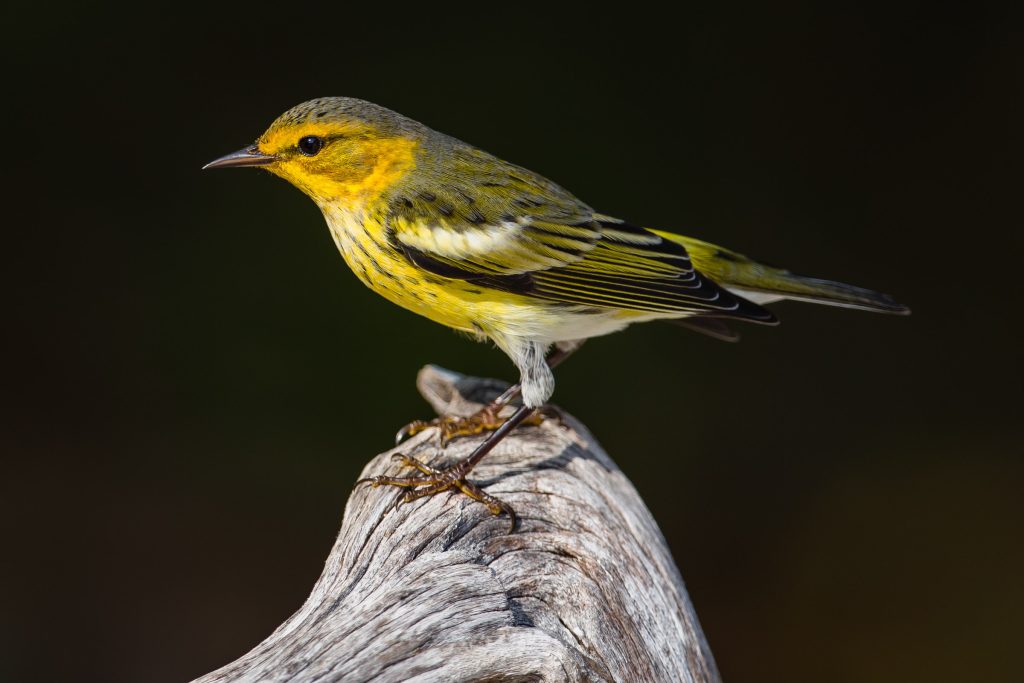
Cape May Warblers are migratory birds that pass through West Virginia during their spring and fall migrations.
These warblers feature a mix of bright yellow and olive-green plumage, with distinct dark streaks on their sides and back. They also have chestnut cheek patches and a yellow rump.
Setophaga tigrina
Length: 4.3-4.7 in (11-12 cm)
Weight: 0.3-0.4 oz (9-11 g)
Wingspan: 7.5-8.7 in (19-22 cm)
Cape May Warblers breed in the boreal forests of Canada and some parts of the northeastern United States. During migration, they travel through various regions, including West Virginia.
You can find Cape May Warblers in forested areas, primarily in the upper tree canopy, where they search for insects, particularly during migration.
Cape May Warbler Song:
Credit: Paul Marvin, XC646478. Accessible at www.xeno-canto.org/646478.
Nests of Cape May Warblers are built high in conifer trees, using twigs, moss, and lichens, lined with finer plant materials. The female lays around four to five eggs, which incubate for about two weeks. The young birds fledge and leave the nest within two weeks.
To attract Cape May Warblers, provide a diverse habitat with trees and shrubs, as well as a consistent food supply of insects during their migration periods.
Fun Fact: Cape May Warblers are known for their unique feeding behavior, where they extract nectar from flowers by piercing the base of the flower with their beaks.
9. Nashville Warbler
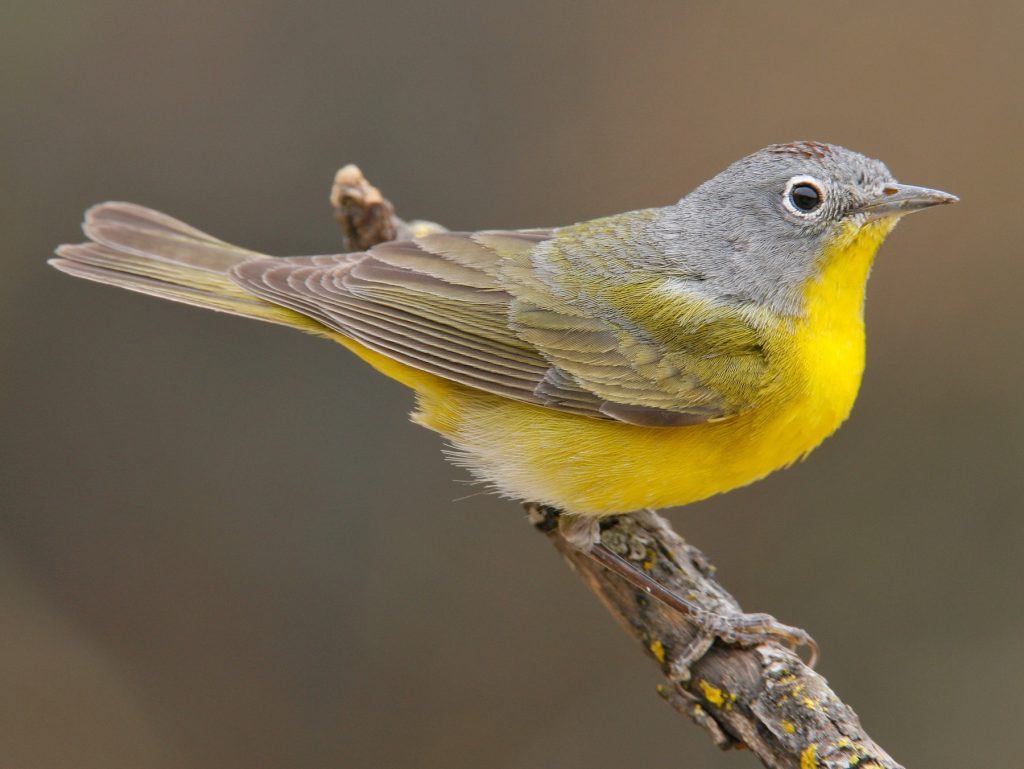
Nashville Warblers pass through West Virginia during their migratory periods, particularly in the spring and fall.
These warblers exhibit olive-green upperparts and bright yellow underparts, with a distinct white eye-ring. They also feature a gray hood and a gray patch on their back.
Leiothlypis ruficapilla
Length: 4.3-4.7 in (11-12 cm)
Weight: 0.3-0.4 oz (8-11 g)
Wingspan: 6.7-7.5 in (17-19 cm)
Nashville Warblers breed in the boreal forests of Canada, primarily in areas with spruce and fir trees. During migration, they pass through various regions, including West Virginia.
You can find Nashville Warblers in woodland areas, especially near streams and wetlands, as they forage for insects and spiders.
Nashville Warbler’s Melodic Chirps:
Credit: Ryan P. O’Donnell, XC585833. Accessible at www.xeno-canto.org/585833.
Nests of Nashville Warblers are built on the ground, often hidden under vegetation, using grass, leaves, and moss, lined with fine grass and hair. The female lays around four to six eggs, which incubate for approximately two weeks. The young birds leave the nest within two weeks of hatching.
To attract Nashville Warblers, provide suitable habitat with woodland areas, particularly near water sources. Offering a variety of insects and spiders will also entice them to visit.
Fun Fact: Nashville Warblers are named after the location where the species was first discovered, Nashville, Tennessee.
10. Wilson’s Warbler

Wilson’s Warblers migrate through West Virginia during their spring and fall migrations.
These warblers are vibrant with bright yellow plumage on their underparts and olive-green coloring on their upperparts. They also have a distinct black cap on their heads.
Cardellina pusilla
Length: 4.3-4.7 in (11-12 cm)
Weight: 0.3-0.4 oz (8-11 g)
Wingspan: 6.7-7.1 in (17-18 cm)
Wilson’s Warblers breed primarily in western North America, including Canada and the western United States. During migration, they pass through various regions, including West Virginia.
You can find Wilson’s Warblers in shrubby areas, particularly near water sources, as they search for insects and spiders.
Wilson’s Warbler’s Lively Chirping:
Credit: Paul Marvin, XC189126. Accessible at www.xeno-canto.org/189126.
Nests of Wilson’s Warblers are typically constructed on the ground, hidden under vegetation, using grass, moss, and leaves, lined with finer plant materials. The female lays around four to six eggs, which incubate for approximately two weeks. The young birds fledge and leave the nest within two weeks.
To attract Wilson’s Warblers, provide suitable habitat with shrubby areas, especially near water sources. Offering a diverse range of insects and spiders will also entice them to visit.
Fun Fact: Wilson’s Warblers are known for their energetic and active foraging behavior, often flicking their wings and tails while searching for food.
11. Orange-crowned Warbler
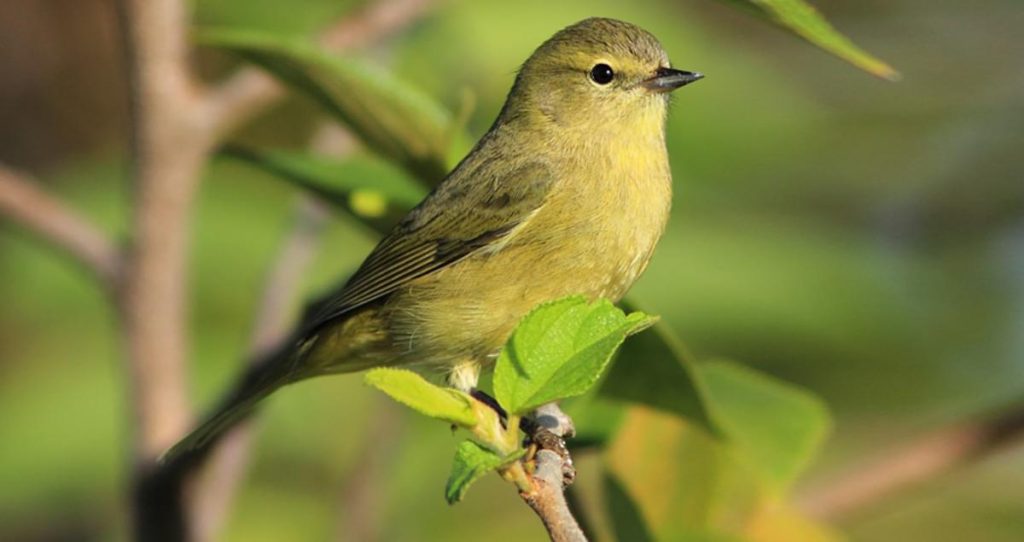
Orange-crowned Warblers migrate through West Virginia during their spring and fall journeys.
These warblers possess a rather plain appearance, with olive-green or grayish plumage. Despite their name, the orange crown is often hidden and not easily visible.
Leiothlypis celata
Length: 4.7-5.1 in (12-13 cm)
Weight: 0.3-0.4 oz (8-11 g)
Wingspan: 6.7-7.5 in (17-19 cm)
Orange-crowned Warblers breed in various regions, including parts of western North America and Canada. During migration, they pass through West Virginia and other areas.
You can find Orange-crowned Warblers in diverse habitats, such as forests, thickets, and even urban parks, as they forage for insects and occasionally consume berries.
Melodious Chirping of the Orange-crowned Warbler:
Credit: Martin St-Michel, XC678991. Accessible at www.xeno-canto.org/678991.
Nests of Orange-crowned Warblers are built low in shrubs or trees, using twigs, leaves, and grass, lined with fine plant materials and hair. The female lays around four to six eggs, which incubate for approximately two weeks. The young birds leave the nest within two weeks of hatching.
To attract Orange-crowned Warblers, provide a variety of habitats, including shrubs and trees. Offering a consistent food supply of insects and providing cover will also make your backyard enticing to them.
Fun Fact: The orange crown of Orange-crowned Warblers is often concealed and may only be visible when the bird is excited or during certain behaviors.
12. American Goldfinch

American Goldfinches can be spotted in West Virginia throughout the year, but their numbers increase during the breeding season. They are recorded in 43% of summer checklists and 29% of winter checklists submitted by birdwatchers in the state.
These popular birds exhibit bright yellow and black coloring in males during spring, while females and males in winter showcase a duller brown plumage.
Spinus tristis
Length: 4.3-5.1 in (11-13 cm)
Weight: 0.4-0.7 oz (11-20 g)
Wingspan: 7.5-8.7 in (19-22 cm)
American Goldfinches can be found across most of North America and are typically resident year-round. However, those that breed in Canada and the Midwest migrate to southern U.S. states for winter.
You can spot American Goldfinches in weedy fields, overgrown areas, suburbs, parks, and backyards, where they forage for seeds from sunflower, thistle, and aster plants.
Song of the American Goldfinch:
Nests of American Goldfinches are usually located in saplings or shrubs. They are made of grass, bark strips, and feathers, and the female lays four to six eggs. The eggs hatch within ten to twelve days, and while the male feeds the female, she incubates the eggs.
To attract American Goldfinches to your backyard, consider planting thistle and milkweed. They are frequent visitors to bird feeders and have a preference for sunflower seeds and nyjer seeds.
Fun Fact: Brown-headed Cowbirds are known for laying eggs in American Goldfinch nests. However, the seed-based diet provided by the goldfinch parents is unsuitable for the cowbird chicks, resulting in their eventual demise.
13. Cedar Waxwing
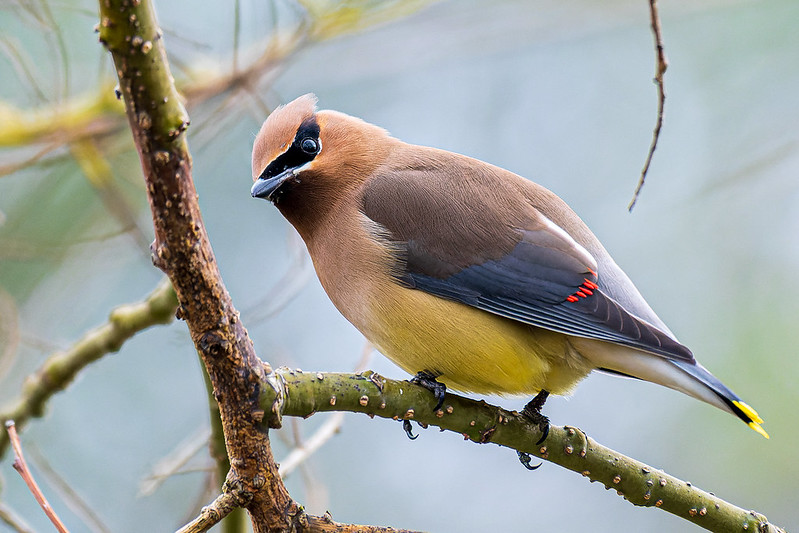
Cedar Waxwings can be spotted in West Virginia all year round, but they are more common during the breeding season. They
appear in 22% of summer checklists and 2% of winter checklists for the state.
These elegant social birds have pale brown heads, chests, and crests, which transition to gray on their backs and wings. They showcase a pale yellow belly and sport bright yellow tips on their tails. A narrow black mask crosses their eyes, and their wingtips are adorned with vibrant red.
Bombycilla cedrorum
Length: 5.5-6.7 in (14-17 cm)
Weight: 1.1 oz (32 g)
Wingspan: 8.7-11.8 in (22-30 cm)
Cedar Waxwings breed in Canada before migrating to the southern United States, Mexico, and Central America for winter. They are resident year-round in northern U.S. states.
You can find Cedar Waxwings in berry bushes, woodlands, grasslands, towns, and along streams. They primarily feed on fruit, but during summer, they also consume insects.
Distinctive Call of the Cedar Waxwing:
Credit: Peter Ward and Ken Hall, XC512254. Accessible at www.xeno-canto.org/512254.
Nests of Cedar Waxwings are built in trees using twigs, grass, hair, and plant materials. They are lined with pine needles and soft grass. The female lays eggs, usually ranging from three to six, and they incubate for approximately twelve days. The young birds leave the nest around sixteen days after hatching.
To attract Cedar Waxwings to your backyard, consider planting native trees and shrubs that bear small fruits, such as serviceberry, dogwood, juniper, winterberry, and hawthorn. Additionally, you can try offering fruit on platform feeders.
Fun Fact: Cedar Waxwings engage in “fruit-sharing” behavior where they pass berries or fruits to one another, often in a line, before consuming them.
14. Scarlet Tanager Female
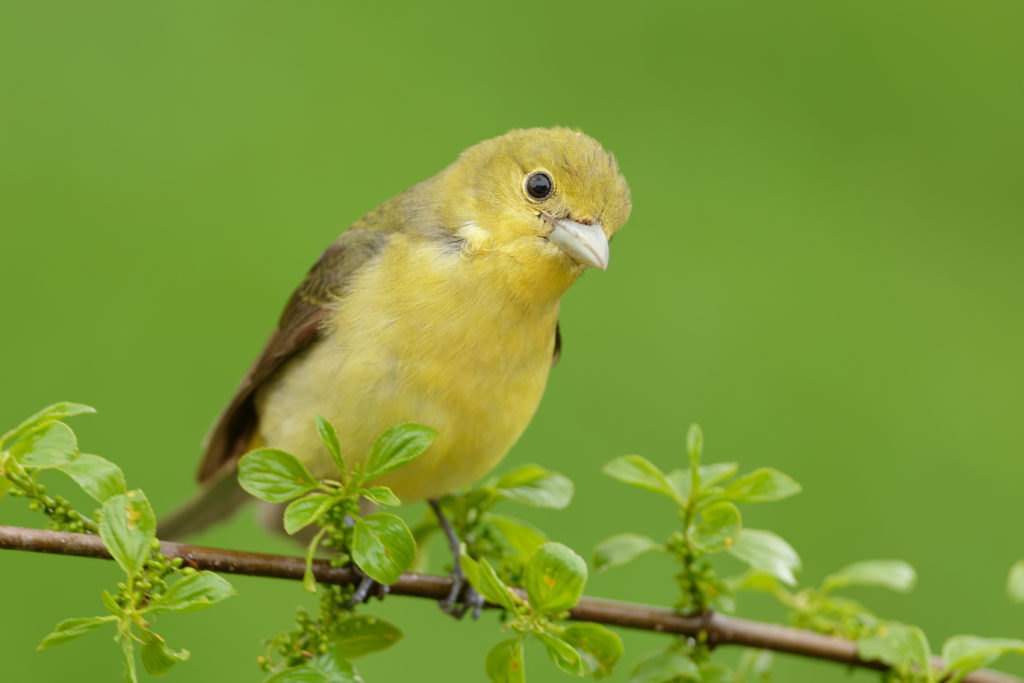
Scarlet Tanagers are primarily spotted during the summer in West Virginia, particularly from April to October. They are recorded in 26% of checklists during this period.
Female Scarlet Tanagers display yellow plumage with darker wings and tails, similar to males after molting.
Male Scarlet Tanagers are brilliantly red birds with black wings and tails. They have thick bills and relatively short tails.
Piranga olivacea
Length: 6.3-6.7 in (16-17 cm)
Weight: 0.8-1.3 oz (23-38 g)
Wingspan: 9.8-11.4 in (25-29 cm)
During summer, Scarlet Tanagers breed in eastern forests before migrating to western South America. They can also be spotted in southeastern states during their migrations.
Scarlet Tanagers tend to remain high in the forest canopy, making them somewhat challenging to observe. However, you may catch a glimpse of their vibrant red plumage as they move along branches in search of insects.
Melodic Song of the Scarlet Tanager:
Credit: Christopher McPherson, XC599850. Accessible at www.xeno-canto.org/599850.
Nests of Scarlet Tanagers are constructed by females in approximately four days. The nests are made from loosely woven twigs, grass, and plant materials. The interior is lined with soft grass, pine needles, and other fine materials. Scarlet Tanagers lay around four eggs, which incubate for two weeks, followed by an additional two weeks for the young to fledge.
To attract Scarlet Tanagers, consider planting berry-producing plants such as blackberries, raspberries, huckleberries, juneberries, serviceberries, mulberries, strawberries, and chokeberries.
Fun Fact: Male Scarlet Tanagers engage in singing battles with rival males, and these confrontations can sometimes escalate into actual physical fights.
15. Common Yellowthroat
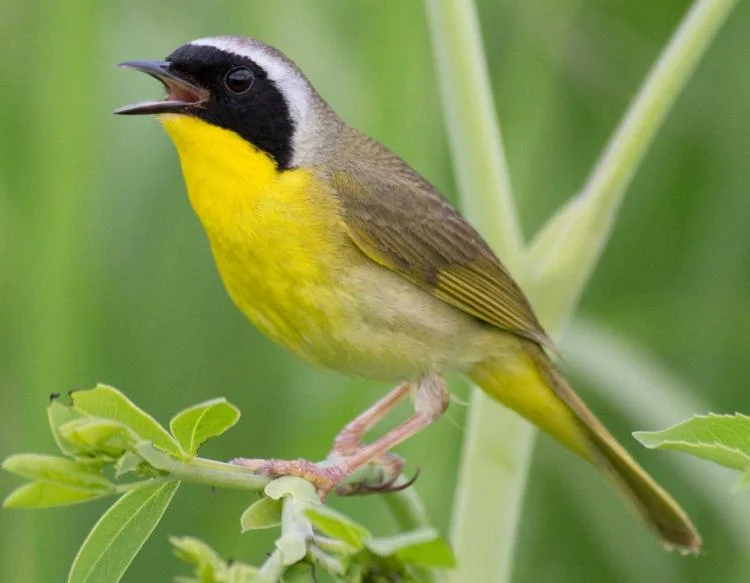
Common Yellowthroats are frequently spotted in West Virginia during the breeding season, appearing in 22% of summer checklists.
These small songbirds have brownish backs and bright yellow undersides, with long tails. Male Common Yellowthroats feature black masks across their faces. The intensity of the yellow coloration can vary geographically, and some individuals may exhibit more olive tones on their undersides.
Geothlypis trichas
Length: 4.3-5.1 in (11-13 cm)
Weight: 0.3-0.3 oz (9-10 g)
Wingspan: 5.9-7.5 in (15-19 cm)
Common Yellowthroats spend the summer breeding across most of North America, excluding Alaska and northern Canada. Some individuals remain year-round along the Gulf Coast and Pacific Southwest, while others migrate south for winter.
You can find Common Yellowthroats in marshy or wetland areas and brushy fields, where they reside amidst thick, tangled vegetation.
Distinctive Call of the Common Yellowthroat:
Credit: Paul Marvin, XC629250. Accessible at www.xeno-canto.org/629250.
Nests of Common Yellowthroats are built by females near the ground in marshy areas, often supported by reeds. The nest is made from grass, sedges, and other plant materials, supported on a platform of leaves and grass. Common Yellowthroats lay up to six eggs, which incubate for approximately twelve days. The young birds fledge within a similar timeframe.
To attract Common Yellowthroats to larger backyards, create dense vegetation with native plants that provide cover and attract insects.
Fun Fact: The black mask of Common Yellowthroats serves as a visual cue to courting males, who become aggressive toward perceived rivals, even attacking models of birds without masks.
16. Black-throated Green Warbler
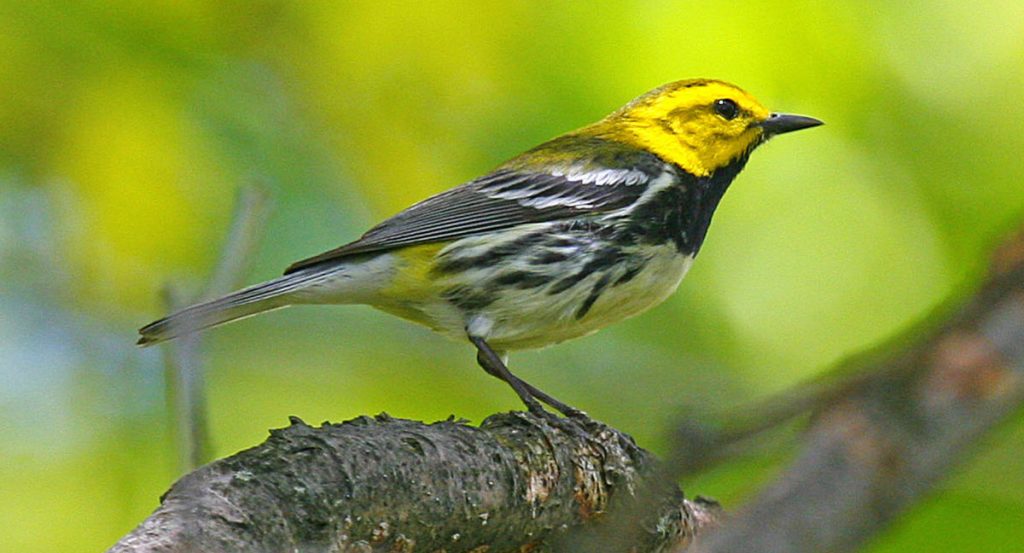
Black-throated Green Warblers are spotted in West Virginia during the summer, from mid-March to October. They appear in 14% of checklists during this time.
These small yellow songbirds have a yellow face and head, olive-yellow backs, and black streaking on their sides and wings. Their underparts are whitish in color. Male Black-throated Green Warblers possess large black patches on their throats, while females and juveniles have smaller ones.
Setophaga virens
Length: 4.3-4.7 in (11-12 cm)
Weight: 0.3-0.4 oz (7-11 g)
Wingspan: 6.7-7.9 in (17-20 cm)
Black-throated Green Warblers primarily breed in eastern forests and migrate to their breeding grounds in northeastern U.S. states and Canada. Their winter range extends to Mexico, northern South America, and the Caribbean.
You can find Black-throated Green Warblers high up in forests, where they feed on insects. Their black throat provides a helpful distinguishing feature from other small yellow birds.
Melodic Song of the Black-throated Green Warbler:
Credit: Paul Driver, XC187636. Accessible at www.xeno-canto.org/187636.
Nests of Black-throated Green Warblers are situated in small trees close to the trunk. They are constructed using twigs, pine needles, grass, and woven bark. The interior is lined with soft grass, moss, and hair. These warblers lay around four eggs, which incubate for about two weeks. The young birds leave the nest approximately two weeks after hatching.
To attract Black-throated Green Warblers to your backyard, provide mature trees that offer suitable nesting locations.
Fun Fact: Male Black-throated Green Warblers can sing over 400 songs per hour and perform a unique “gloating” flight after successfully driving away rivals.
17. American Redstart Female
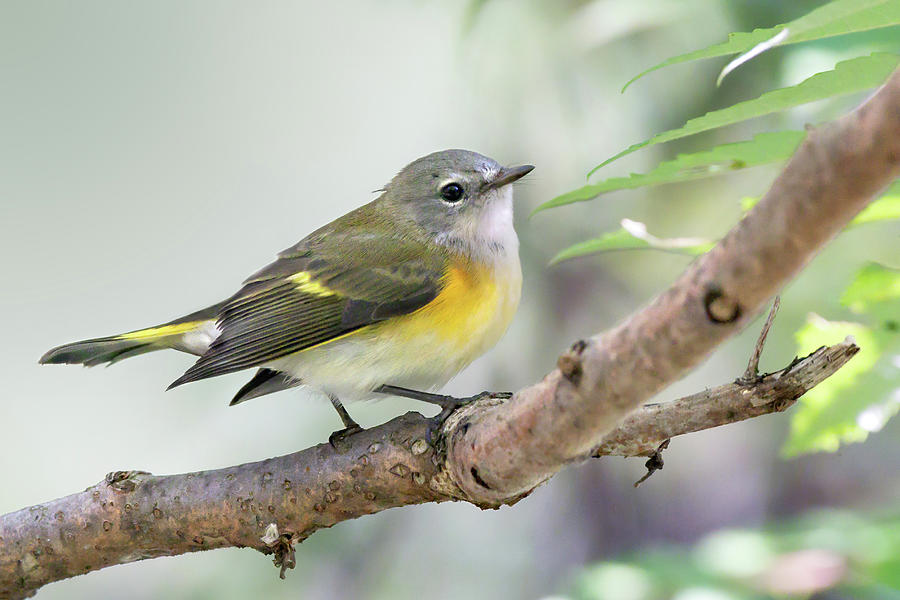
American Redstarts are primarily seen in West Virginia from April to October, appearing in 16% of summer checklists for the state.
Male American Redstarts are mostly black with bright orange patches and a white belly. Females, on the other hand, display olive-gray plumage instead of black, with numerous yellow patches.
Setophaga ruticilla
Length: 4.3-5.1 in (11-13 cm)
Weight: 0.2-0.3 oz (6-9 g)
Wingspan: 6.3-7.5 in (16-19 cm)
American Redstarts breed in eastern U.S. states and Canada, including the northwestern U.S. During migration, they may also be observed in central and western U.S. states.
You can find American Redstarts in deciduous woodlands, where they actively search for insects. They can also be found in backyards and thickets, where they feed on berries such as serviceberry and magnolia.
Distinctive Song of the American Redstart:
Credit: Nick Kiehl, XC522368. Accessible at www.xeno-canto.org/522368.
Nests of American Redstarts are built near the trunk of trees or large shrubs, using bark, grass, and other plant materials. They lay up to five eggs, which incubate for just under two weeks. The young birds leave the nest within a week or two after hatching.
To attract American Redstarts to your backyard, plant berry-producing trees such as magnolia and serviceberry.
Fun Fact: American Redstart parents selectively feed certain chicks, rather than feeding them all indiscriminately.
18. Eastern Meadowlark
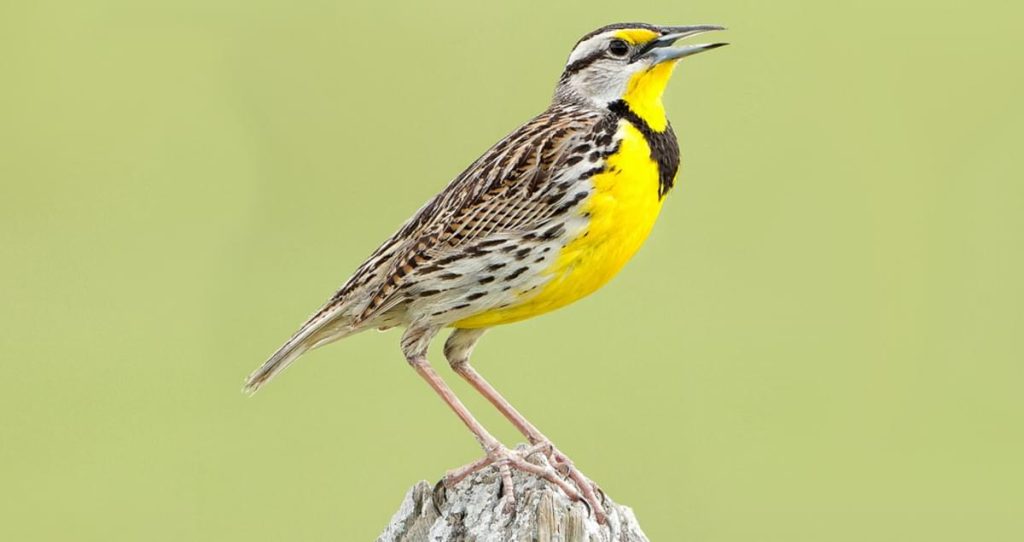
Eastern Meadowlarks are near-threatened species in West Virginia and can be seen throughout the year, with the highest presence from March to July. They appear in around 10% of summer checklists and 1% of winter checklists.
These medium-sized songbirds have bright yellow undersides and pale brown plumage with distinctive black markings on their backs. They also feature a black band across their chests.
Sturnella magna
Length: 7.5-10.2 in (19-26 cm)
Weight: 3.2-5.3 oz (90-150 g)
Wingspan: 13.8-15.8 in (35-40 cm)
Eastern Meadowlarks are found across eastern U.S. states throughout the year. They also breed in the Northeast and Canada before embarking on their southward migration.
You can spot Eastern Meadowlarks in grasslands, prairies, and open fields, where they forage for insects. During winter, they gather in large flocks, often in fields, searching for seeds.
Distinctive Calls of the Eastern Meadowlark:
Credit: Dawn Hough, XC645468. Accessible at www.xeno-canto.org/645468.
Nests of Eastern Meadowlarks are built on the ground and can feature intricate constructions, including tunnels and woven roofs made of grasses.
Fun Fact: Eastern Meadowlarks can sing more than 100 different songs, which vary among individuals and regions.
19. Baltimore Oriole Female

Baltimore Orioles are typically seen in West Virginia during the breeding season, from mid-April to September. They appear in 16% of summer checklists.
These birds are known for their vibrant colors, with adult males sporting bright orange and black plumage along with white wing bars. Females, on the other hand, have yellowish undersides and heads, with grayish-brown wings and backs. Baltimore Orioles are about the size of a Robin but possess a more slender physique. They belong to the blackbird family.
Icterus galbula
Length: 6.7-7.5 in (17-19 cm)
Weight: 1.1-1.4 oz (30-40 g)
Wingspan: 9.1-11.8 in (23-30 cm)
Baltimore Orioles breed in Eastern and Central states, including central-southern Canadian provinces and regions along the southern U.S. border. After breeding, they migrate to Florida, Central America, and the Caribbean for winter, with some departing as early as July.
You can find Baltimore Orioles high up in open woodlands, along riverbanks, and at forest edges, where they forage for insects. They are also known to visit parks and backyards.
Distinctive Song of the Baltimore Oriole:
Credit: Richard E. Webster, XC662546. Accessible at www.xeno-canto.org/662546.
The diet of Baltimore Orioles consists primarily of insects such as beetles, crickets, grasshoppers, spiders, and snails. They also have a wide variety of fruit in their diet, but they can occasionally cause damage to crops like raspberries, mulberries, cherries, bananas, and oranges.
To attract Baltimore Orioles to your backyard, try offering halved oranges on a platform feeder or hanging them from trees. Oriole feeders filled with sugar water can also be effective. Planting fruit-bearing plants and nectar plants like raspberries, crab apples, and trumpet vines will further entice them.
Fun Fact: Baltimore Orioles construct hanging bag-like nests woven from fibers, which are an impressive sight to behold.
20. Yellow Warbler
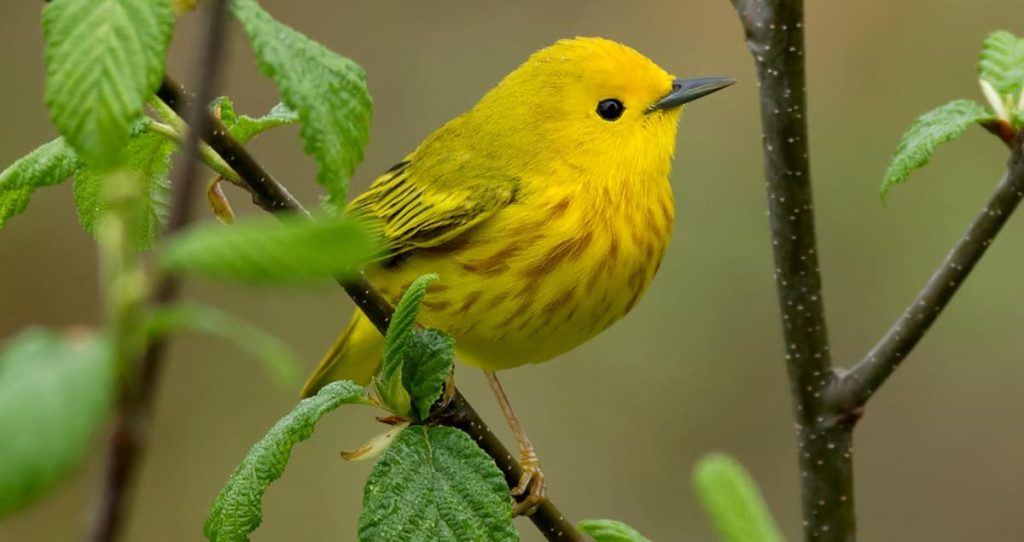
Yellow Warblers spend their summers in West Virginia and appear in 15% of checklists during this time. They are mainly observed from April to September, although a few may stay until mid-November.
These small, bright yellow birds have a yellow-green back, and male individuals possess chestnut streaks on their breasts. Females and juveniles are not as vibrant as the males.
Setophaga petechia
Length: 4.7-5.1 in (12-13 cm)
Weight: 0.3-0.4 oz (9-11 g)
Wingspan: 6.3-7.9 in (16-20 cm)
Yellow Warblers migrate long distances to breed in Canada and the U.S. (excluding southeastern states) before heading back to Central and South America for winter. However, they can be spotted during migration in southeastern U.S. states.
You can find Yellow Warblers along streams, wetlands, and thickets, where they actively search for insects, including caterpillars, midges, beetles, bugs, and wasps.
Melodic Song of the Yellow Warbler:
Credit: Paul Marvin, XC662546. Accessible at www.xeno-canto.org/662546.
Nests of Yellow Warblers are built in small trees or shrubs using bark, grass, and plant materials woven together and secured with spider webs. The nests are then lined with softer materials such as hair, feathers, and plant down. These warblers lay up to seven eggs, which incubate for around twelve days. The young birds leave the nest approximately two weeks after hatching.
To attract Yellow Warblers to your backyard, provide suet, oranges, peanut butter, and plants that bear berries. Additionally, planting native species that attract insects without the use of pesticides or excessive tidiness will create a welcoming habitat. Birdbaths with fountains placed near secluded plantings can also provide protection and appeal to these birds.
Fun Fact: Yellow Warblers often face the challenge of Brown-headed Cowbirds, which lay their eggs in Yellow Warbler nests. However, the diet provided by the Yellow Warbler parents is not suitable for the Cowbird chicks, resulting in their eventual demise.
21. Hooded Warbler
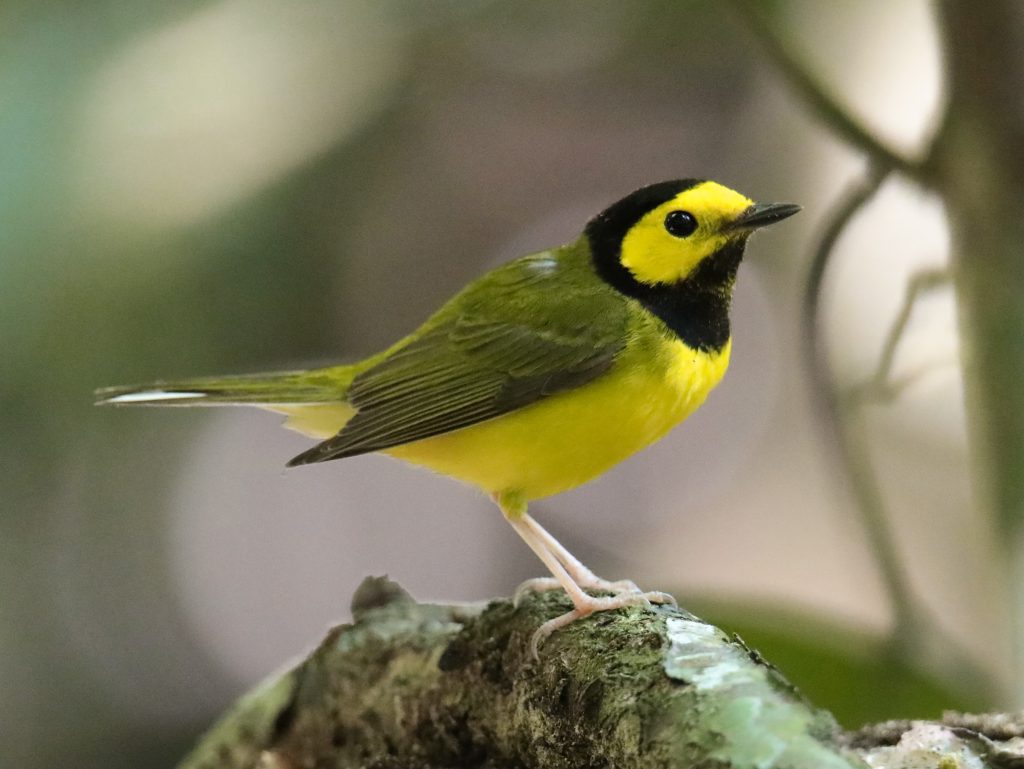
Hooded Warblers are spotted in West Virginia during the summer, primarily from April to September. They appear in 8% of checklists during this time.
These small songbirds have vibrant yellow plumage, with black hoods covering their heads and throats. The females have a similar appearance, but their coloring is less intense.
Setophaga citrina
Length: 4.7-5.1 in (12-13 cm)
Weight: 0.3-0.4 oz (9-11 g)
Wingspan: 7.5-8.3 in (19-21 cm)
Hooded Warblers breed in the eastern U.S. and parts of the Midwest before migrating to wintering grounds in Mexico and Central America.
You can find Hooded Warblers in dense, moist undergrowth of forests, where they forage for insects and spiders. They often remain hidden within vegetation but can be identified by their distinctive song.
Distinctive Song of the Hooded Warbler:
Credit: Willem-Pier Vellinga, XC565002. Accessible at www.xeno-canto.org/565002.
Nests of Hooded Warblers are built on or near the ground, hidden amidst vegetation. They are constructed using twigs, leaves, and bark, and the interior is lined with fine grasses and plant fibers. These warblers lay around three to five eggs, which incubate for approximately 12 days. The young birds leave the nest about 10 days after hatching.
To attract Hooded Warblers to your backyard, create dense shrubby areas and provide a water source. Native plants that bear berries and attract insects will also enhance their presence.
Fun Fact: Hooded Warblers have a unique breeding behavior where males build multiple incomplete nests within their territories. The female will choose one of these nests and complete it for egg-laying.
22. Yellow-throated Warbler
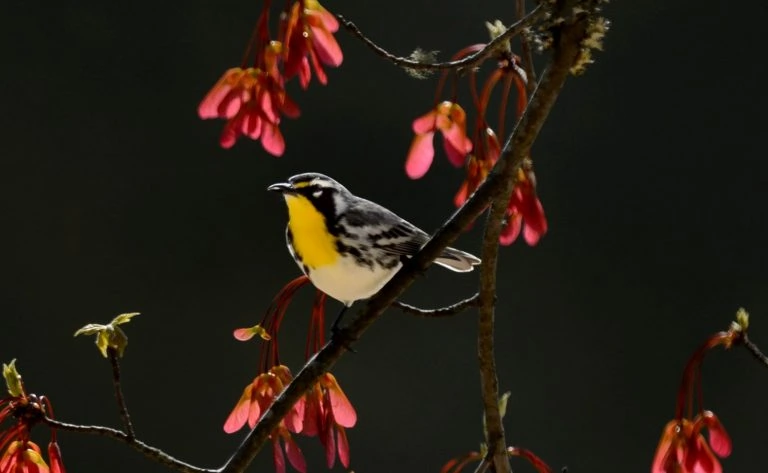
Yellow-throated Warblers can be observed in West Virginia during the summer months, typically from April to September. They appear in approximately 4% of checklists during this period.
These medium-sized warblers showcase a striking combination of yellow and black. They have bright yellow undersides and throats, contrasting with their black upperparts, wings, and tails. They also possess a distinct black mask around their eyes.
Setophaga dominica
Length: 5.1-5.5 in (13-14 cm)
Weight: 0.3-0.4 oz (9-11 g)
Wingspan: 8.3-9.1 in (21-23 cm)
Yellow-throated Warblers breed in the southeastern United States and parts of the Midwest before migrating to their wintering grounds in southern Florida, the Caribbean, and Central America.
These warblers prefer mature deciduous forests, particularly those with tall trees and open understory. They forage for insects and spiders among the foliage and tree canopies.
Distinctive Song of the Yellow-throated Warbler:
Credit: Gregory F. Budney, XC253758. Accessible at www.xeno-canto.org/253758.
Nests of Yellow-throated Warblers are built in the forks of tree branches, usually high above the ground. They are constructed using grass, twigs, bark strips, and spiderwebs, creating a sturdy cup-shaped structure. The female lays around three to five eggs, which incubate for approximately two weeks. The young birds fledge and leave the nest after about nine to ten days.
Attracting Yellow-throated Warblers to your backyard can be achieved by planting a variety of native trees and shrubs that provide suitable nesting sites and attract insects.
Fun Fact: Yellow-throated Warblers have a unique feeding behavior known as “gleaning,” where they glean insects from the undersides of leaves and twigs.
23. White-eyed Vireo
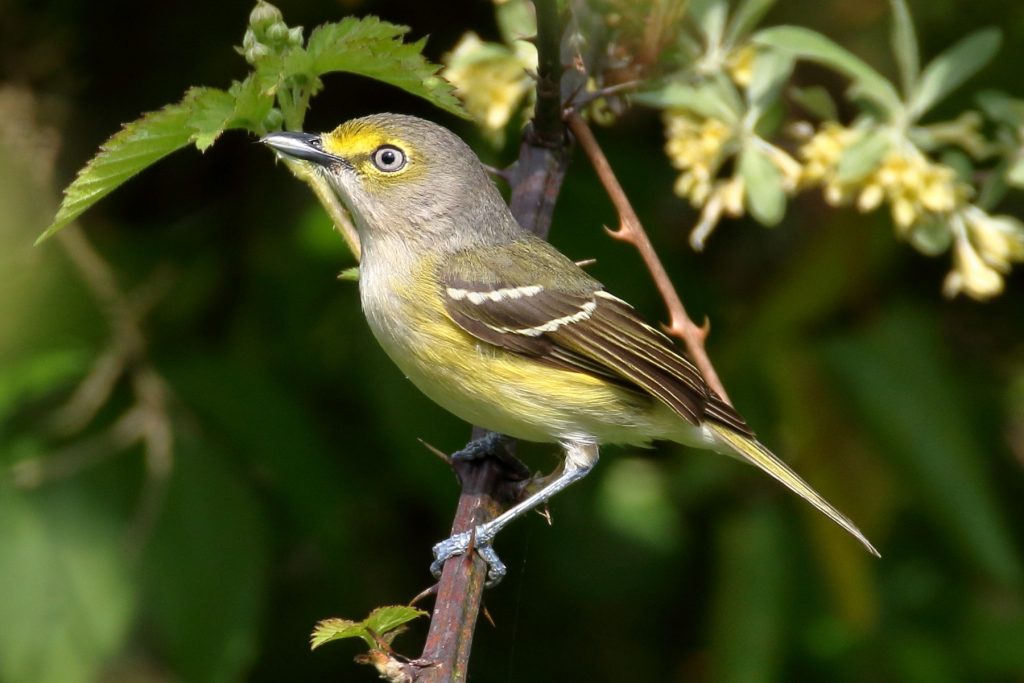
White-eyed Vireos can be spotted in West Virginia during the summer breeding season, usually from April to September. They appear in approximately 4% of checklists during this time.
These small songbirds have bright yellow underparts and olive-green upperparts. They feature a distinctive white eye-ring, giving them their name.
Vireo griseus
Length: 4.7-5.1 in (12-13 cm)
Weight: 0.4-0.5 oz (11-14 g)
Wingspan: 7.5-8.3 in (19-21 cm)
White-eyed Vireos breed in the southeastern United States, including parts of West Virginia, before migrating to wintering grounds in southern Florida, Mexico, and Central America.
These vireos inhabit shrubby areas, thickets, and woodland edges, where they actively search for insects. They are known for their energetic and often hidden behavior within vegetation.
Distinctive Song of the White-eyed Vireo:
Credit: Andrew Spencer, XC536774. Accessible at www.xeno-canto.org/536774.
Nests of White-eyed Vireos are built in low shrubs, typically a few feet above the ground. They are cup-shaped structures made of grasses, bark strips, and plant fibers, with spider silk used to bind the materials together. The female lays three to five eggs, which incubate for approximately 12-14 days. The young birds leave the nest around 10-12 days after hatching.
To attract White-eyed Vireos to your backyard, create dense shrubby areas with a variety of native plants that provide food sources and suitable nesting sites.
Fun Fact: White-eyed Vireos are
known for their complex song, which can vary among individuals and populations.
24. Yellow-throated Vireo
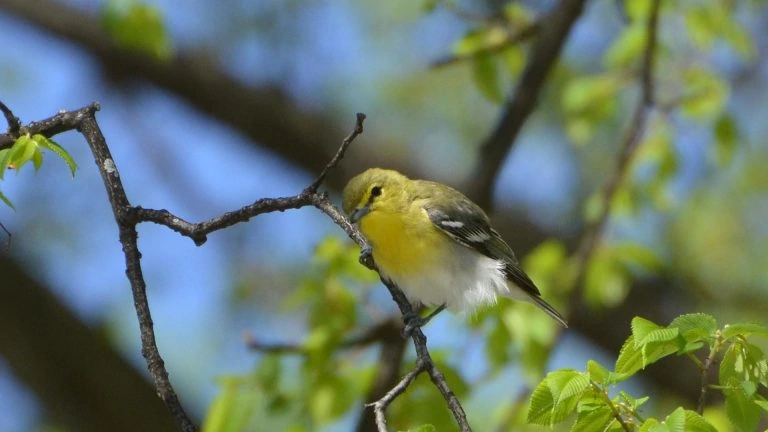
Yellow-throated Vireos can be observed in West Virginia during the summer months, typically from April to September. They appear in approximately 3% of checklists during this period.
These medium-sized vireos display a mix of bright yellow and olive-green plumage. They have a vibrant yellow throat and yellow spectacles around their eyes.
Vireo flavifrons
Length: 5.5-6.3 in (14-16 cm)
Weight: 0.4-0.6 oz (12-17 g)
Wingspan: 9.1-10.2 in (23-26 cm)
Yellow-throated Vireos breed in the eastern United States and parts of Canada before migrating to wintering grounds in Central and South America.
These vireos prefer deciduous and mixed forests, particularly those near water. They actively forage for insects, often in the upper canopy of trees.
Distinctive Song of the Yellow-throated Vireo:
Credit: Paul Driver, XC545868. Accessible at www.xeno-canto.org/545868.
Nests of Yellow-throated Vireos are built in the forked branches of trees, usually near the trunk. They are cup-shaped structures constructed with grass, plant fibers, and spider silk. The female lays three to five eggs, which incubate for approximately 12-14 days. The young birds fledge and leave the nest after about 10-12 days.
Attracting Yellow-throated Vireos to your backyard can be accomplished by providing a diverse habitat with tall trees and nearby water sources.
Fun Fact: Yellow-throated Vireos have a distinct call that resembles the phrase “you see it, you know it, you get it.”
25. Orchard Oriole
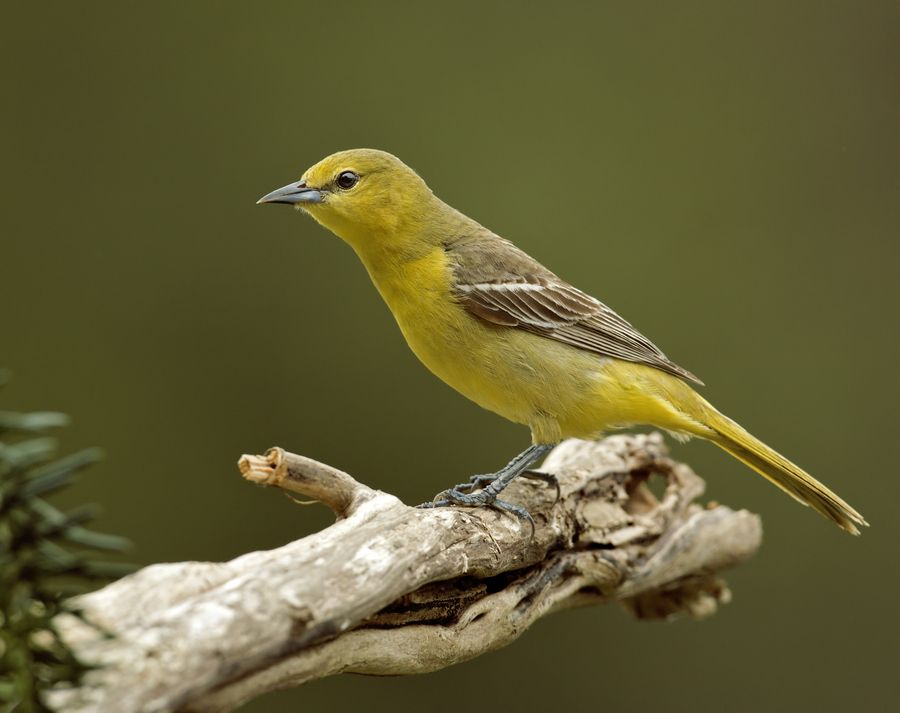
Orchard Orioles can be spotted in West Virginia during the summer months, primarily from late April to September. They appear in approximately 3% of checklists during this time.
These small orioles exhibit sexually dimorphic plumage, with the males having bright chestnut plumage on their undersides and black wings and tails. The females, on the other hand, have olive-green upperparts and yellowish undersides.
Icterus spurius
Length: 6.3-7.1 in (16-18 cm)
Weight: 0.6-0.8 oz (18-23 g)
Wingspan: 9.1-10.2 in (23-26 cm)
Orchard Orioles breed in the eastern and central United States before migrating to wintering grounds in Mexico, Central America, and northern South America.
These orioles favor open woodlands, orchards, and forest edges. They feed on nectar, fruit, and insects, often foraging among flowering trees and shrubs.
Distinctive Song of the Orchard Oriole:
Credit: Brian Henderson, XC393375. Accessible at www.xeno-canto.org/393375.
Nests of Orchard Orioles are intricately woven structures that hang from the outer branches of trees. They are made of grass, plant fibers, and other materials, with a central cup-shaped cavity for eggs. The female lays three to six eggs, which incubate for approximately 12-14 days. The young birds fledge and leave the nest after about two weeks.
To attract Orchard Orioles to your backyard, provide a variety of flowering trees, shrubs, and nectar feeders. Offering ripe fruits and insects will also help entice them.
Fun Fact: Orchard Orioles are known for their acrobatic flight displays, where males perform a series of aerial maneuvers
to attract females.
26. Magnolia Warbler
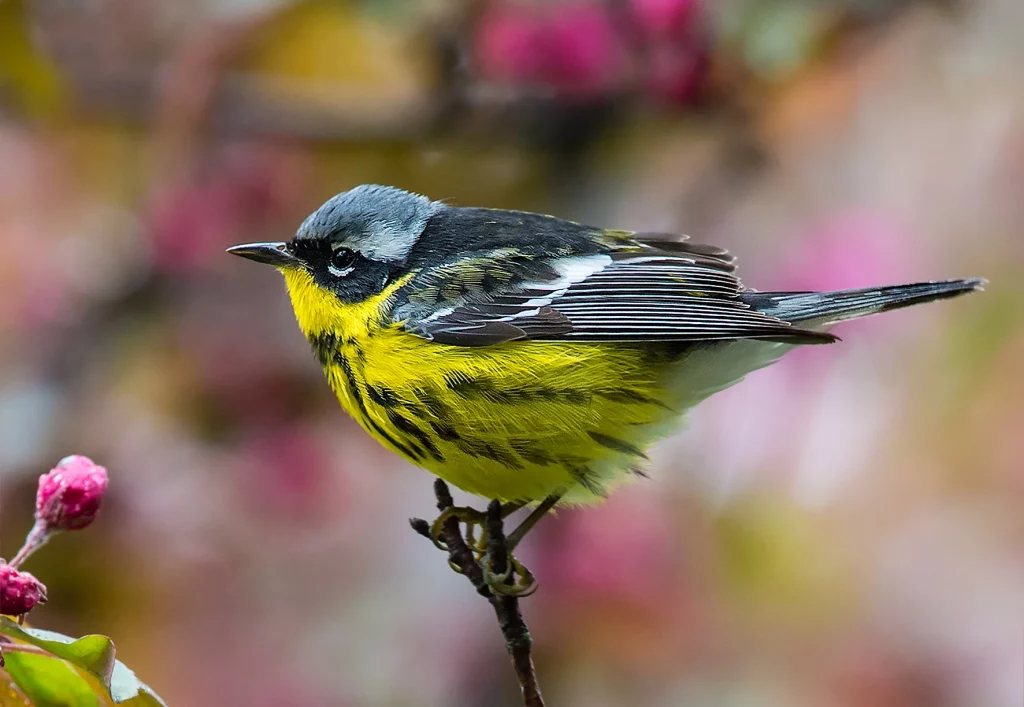
Magnolia Warblers can be observed in West Virginia during their migratory journeys, typically from late April to early May and then again in September. They appear in approximately 3% of checklists during these periods.
These small warblers exhibit a striking appearance, with bright yellow undersides, black streaking on their breasts and sides, and a bold black necklace. They also feature white wing bars and a yellow patch on their rump.
Setophaga magnolia
Length: 4.3-5.1 in (11-13 cm)
Weight: 0.3-0.4 oz (9-11 g)
Wingspan: 7.5-8.7 in (19-22 cm)
Magnolia Warblers breed in the boreal forests of Canada and Alaska before migrating to wintering grounds in Central and South America.
During migration, these warblers can be found in a variety of habitats, including woodlands, forest edges, and gardens. They forage actively for insects among the foliage and tree canopies.
Distinctive Song of the Magnolia Warbler:
Credit: Benjamin Clock, XC678315. Accessible at www.xeno-canto.org/678315.
Nests of Magnolia Warblers are built in the understory of coniferous trees. They are cup-shaped structures made of twigs, grasses, and plant fibers, lined with softer materials like moss and hair. The female lays four to five eggs, which incubate for approximately 12-14 days. The young birds fledge and leave the nest after about nine to ten days.
Magnolia Warblers primarily pass through West Virginia during migration, so attracting them to your backyard can be challenging. Providing natural habitat elements such as trees, shrubs, and insect-attracting plants can increase the likelihood of spotting them.
Fun Fact: Despite its name, the Magnolia Warbler does not rely on magnolia trees for nesting. It was named after French botanist Pierre Magnol, who did extensive work on plant taxonomy.
27. Pine Warbler
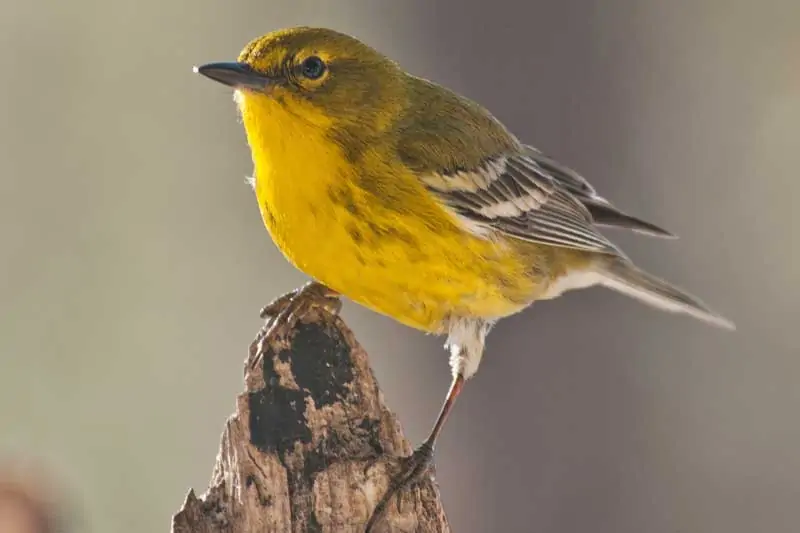
Pine Warblers can be observed in West Virginia throughout the year, although they are more commonly seen during the breeding season. They appear in approximately 3% of checklists in spring and summer.
These small warblers showcase a mix of olive-green and yellow plumage. They have bright yellow undersides and faces, with olive-green upperparts. During the breeding season, males may develop a more vibrant yellow coloration.
Setophaga pinus
Length: 4.7-5.1 in (12-13 cm)
Weight: 0.3-0.4 oz (9-11 g)
Wingspan: 7.5-9.1 in (19-23 cm)
Pine Warblers breed in the eastern United States and parts of Canada before migrating to wintering grounds in the southeastern United States.
These warblers inhabit pine forests and are often found in the upper canopy. They forage for insects and spiders among the needles and branches of pine trees.
Distinctive Song of the Pine Warbler:
Credit: Andrew Spencer, XC568043. Accessible at www.xeno-canto.org/568043.
Nests of Pine Warblers are built in the outer branches of pine trees, usually 20 to 60 feet above the ground. They are cup-shaped structures made of twigs, grasses, and pine needles, with a lining of softer materials like feathers and hair. The female lays three to five eggs, which incubate for approximately 12-14 days. The young birds fledge and leave the nest after about ten to eleven days.
Attracting Pine Warblers to your backyard can be achieved by providing pine trees
and maintaining a natural habitat with suitable food sources and nesting opportunities.
Fun Fact: Pine Warblers are one of the few warbler species that regularly sing during the winter months.
28. Blue-winged Warbler
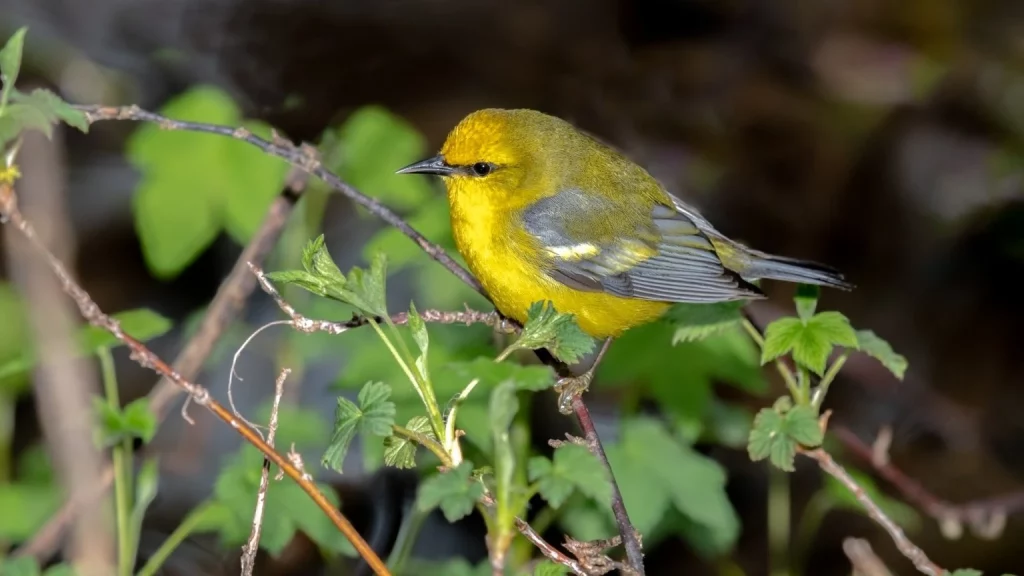
Blue-winged Warblers can be observed in West Virginia during the summer months, typically from late April to September. They appear in approximately 3% of checklists during this period.
These small warblers display a unique combination of bright yellow undersides, olive-green upperparts, and distinctive blue-gray wings. They also feature a bold black eye-line and a yellow patch on their forehead.
Vermivora cyanoptera
Length: 4.7-5.5 in (12-14 cm)
Weight: 0.3-0.4 oz (9-11 g)
Wingspan: 7.5-8.7 in (19-22 cm)
Blue-winged Warblers breed in the eastern United States before migrating to wintering grounds in Central and South America.
These warblers prefer early successional habitats, such as shrubby areas, young forests, and woodland edges. They forage for insects among the foliage and low vegetation.
Distinctive Song of the Blue-winged Warbler:
Credit: Andrew Spencer, XC650888. Accessible at www.xeno-canto.org/650888.
Nests of Blue-winged Warblers are built on or near the ground, hidden in grasses or low shrubs. They are cup-shaped structures made of grasses, bark fibers, and other plant materials, with a lining of softer materials. The female lays four to six eggs, which incubate for approximately 11-12 days. The young birds fledge and leave the nest after about nine to ten days.
Attracting Blue-winged Warblers to your backyard can be accomplished by creating shrubby habitats and maintaining open areas with sufficient insect populations.
Fun Fact: Blue-winged Warblers often hybridize with Golden-winged Warblers, resulting in a hybrid species called the Brewster’s Warbler or Lawrence’s Warbler, which displays characteristics of both parent species.
29. Prairie Warbler
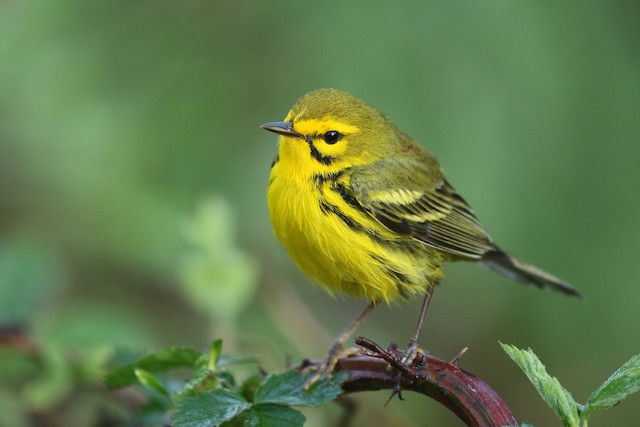
Prairie Warblers can be observed in West Virginia during the summer months, typically from late April to September. They appear in approximately 3% of checklists during this period.
These small warblers exhibit a mix of bright yellow and olive-green plumage. They have yellow undersides with bold black streaking on their breasts and sides. They also feature a distinctive black face mask and yellow eye crescents.
Setophaga discolor
Length: 4.3-5.1 in (11-13 cm)
Weight: 0.3-0.4 oz (9-11 g)
Wingspan: 7.1-8.3 in (18-21 cm)
Prairie Warblers breed in the eastern United States and parts of Canada before migrating to wintering grounds in the Caribbean and Central America.
These warblers inhabit shrubby areas, open woodlands, and forest edges. They actively forage for insects among the foliage and low vegetation.
Distinctive Song of the Prairie Warbler:
Credit: Benjamin Clock, XC612117. Accessible at www.xeno-canto.org/612117.
Nests of Prairie Warblers are built low to the ground, usually in shrubs or small trees. They are cup-shaped structures made of grasses, leaves, and plant fibers, lined with finer materials. The female lays three to five eggs, which incubate for approximately 11-12 days. The young birds fledge and leave the nest after about nine to ten days.
To attract Prairie Warblers to your backyard, provide a mix of shrubby vegetation, open spaces, and insect-attracting plants.
Fun Fact: Prairie Warblers are known for their unique mating behavior, where males build multiple incomplete nests called “dummy nests” to attract females. The female then selects one of the nests to complete and use for breeding.
30. Scarlet Tanager
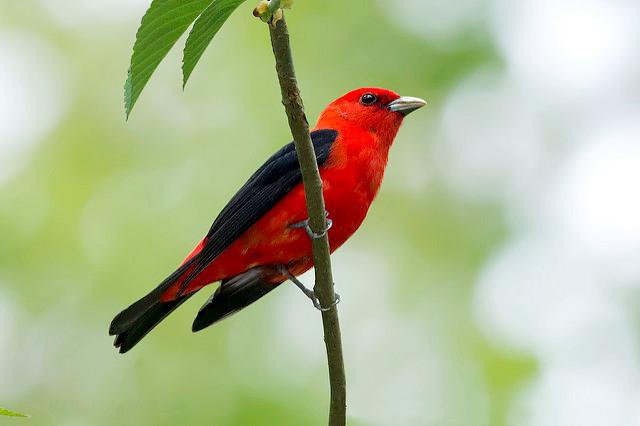
Scarlet Tanagers can be spotted in West Virginia during the summer months, typically from late April to September. They appear in approximately 3% of checklists during this time.
The males of this species are known for their vibrant plumage, displaying a brilliant scarlet red coloration. The females, however, have more subdued olive-green plumage with yellowish underparts.
Piranga olivacea
Length: 6.3-7.1 in (16-18 cm)
Weight: 0.9-1.2 oz (26-34 g)
Wingspan: 9.8-11.4 in (25-29 cm)
Scarlet Tanagers breed in the eastern United States and parts of Canada before migrating to wintering grounds in northern South America.
These tanagers inhabit deciduous and mixed forests, particularly areas with mature trees. They forage for insects by actively searching for them among the foliage.
Distinctive Song of the Scarlet Tanager:
Credit: Andrew Spencer, XC570679. Accessible at www.xeno-canto.org/570679.
Nests of Scarlet Tanagers are built high in the canopy of trees, usually 20 to 60 feet above the ground. They are cup-shaped structures made of twigs, grasses, and other plant materials, with a lining of finer materials. The female lays three to five eggs, which incubate for approximately 12-14 days. The young birds fledge and leave the nest after about nine to ten days.
Attracting Scarlet Tanagers to your backyard can be challenging as they primarily inhabit forested areas. Providing a diverse habitat with mature trees, berries, and insects can increase the chances of attracting them.
Fun Fact: Male Scarlet Tanagers transition from their vibrant red breeding plumage to a more olive-green plumage during their molt, resembling the appearance of females and young males.
